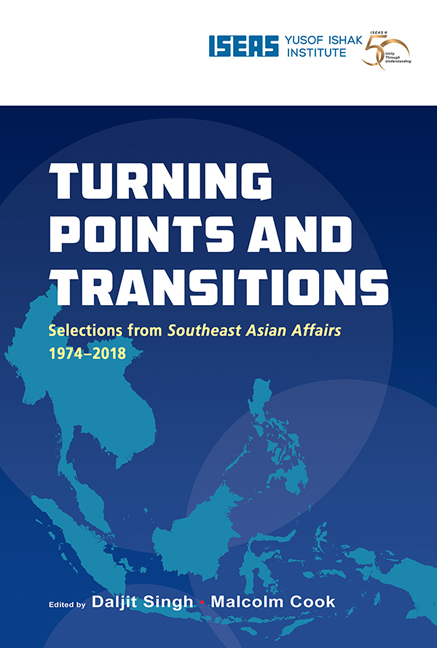Book contents
- Frontmatter
- Contents
- Message from the Director
- Foreword
- Foreword
- Introduction
- THE REGION
- The Diplomatic Emergence of China and Its Implications for Southeast Asia (1975*)
- Stability and Security in the Region after ANZUK (1975)
- The Question of the “Overseas Chinese” (1976)
- Southeast Asia 1976: The Handling of Contradictions (1977)
- The “Fukuda Doctrine” and Its Implications for Southeast Asia (1978)
- Expanding Horizons in Southeast Asia? (1994)
- AFTA in the Light of New Economic Developments (1995)
- The ASEAN Economic Miracle Unravels (1999)
- Southeast Asia in 1999: A False Dawn? (2000)
- East Timor's Future: Southeast Asian or South Pacific? (2001)
- Southeast Asia in 2002: From Bali to Iraq — Co-operating for Security (2003)
- The Year in ASEAN: The Charter, Trade Agreements, and the Global Economic Crisis (2010)
- Seeking Stability in Turbulent Times: Southeast Asia's New Normal? (2015)
- China's Two Silk Roads Initiative: What It Means for Southeast Asia (2015)
- China's International Strategy and Its Implications for Southeast Asia (2016)
- BRUNEI
- CAMBODIA
- INDONESIA
- LAOS
- MALAYSIA
- MYANMAR
- THE PHILIPPINES
- SINGAPORE
- THAILAND
- VIETNAM
Seeking Stability in Turbulent Times: Southeast Asia's New Normal? (2015)
from THE REGION
Published online by Cambridge University Press: 29 May 2019
- Frontmatter
- Contents
- Message from the Director
- Foreword
- Foreword
- Introduction
- THE REGION
- The Diplomatic Emergence of China and Its Implications for Southeast Asia (1975*)
- Stability and Security in the Region after ANZUK (1975)
- The Question of the “Overseas Chinese” (1976)
- Southeast Asia 1976: The Handling of Contradictions (1977)
- The “Fukuda Doctrine” and Its Implications for Southeast Asia (1978)
- Expanding Horizons in Southeast Asia? (1994)
- AFTA in the Light of New Economic Developments (1995)
- The ASEAN Economic Miracle Unravels (1999)
- Southeast Asia in 1999: A False Dawn? (2000)
- East Timor's Future: Southeast Asian or South Pacific? (2001)
- Southeast Asia in 2002: From Bali to Iraq — Co-operating for Security (2003)
- The Year in ASEAN: The Charter, Trade Agreements, and the Global Economic Crisis (2010)
- Seeking Stability in Turbulent Times: Southeast Asia's New Normal? (2015)
- China's Two Silk Roads Initiative: What It Means for Southeast Asia (2015)
- China's International Strategy and Its Implications for Southeast Asia (2016)
- BRUNEI
- CAMBODIA
- INDONESIA
- LAOS
- MALAYSIA
- MYANMAR
- THE PHILIPPINES
- SINGAPORE
- THAILAND
- VIETNAM
Summary
Political and security developments in Southeast Asia in 2014 reflect efforts on the part of Southeast Asian countries as well as ASEAN (the Association of Southeast Asian Nations) to adjust and adapt to the conditions and circumstances of a “new normal” in the wider Asia-Pacific region: a rapidly changing regional strategic environment where emerging powers display greater assertiveness and assurance of their newfound status, whilst established powers experience relative decline and seek to rebalance against the growing power and influence of their rivals. China's rising power and influence appears to have grown from strength to strength, notwithstanding putative efforts by the United States, Japan and others to balance against it partly through rallying Southeast Asian partners in support of their cause. Adding to the growing prospect of regional instability and turbulence was Russia's annexation of Crimea in March, which raised fears among some Southeast Asians over the prospective emulation of Russia's action by more powerful claimant states over the South China Sea region.
At the same time within Southeast Asia, a number of states and societies underwent political transition. Indonesia conducted a successful presidential election in July which saw a popular non-establishment figure, the then Jakarta Governor Joko Widodo (or “Jokowi”), win the presidency. It remains unclear at this point what Jokowi's foreign policy will look like. However, there are early hints that Indonesia might not be as fixated with ASEAN as in the past. Going beyond the “Indo- Pacific” idea advanced by the Yudhoyono administration, the Jokowi administration's vision for Indonesia is as a global maritime fulcrum connecting the Indian and Pacific Oceans. Known as “PACINDO”, the area of engagement envisioned here is ostensibly geographically more extensive than the Indo-Pacific region the Yudhoyono administration had in mind. To that end, India and the Gulf states have been identified as countries with whom Jokowi would engage more deeply. As a foreign policy adviser to Jokowi has declared: “We used to say ASEAN is the cornerstone of our foreign policy. Now we change it to a cornerstone of our foreign policy.”
After considerable unrest in Thailand caused by the rift between the so-called “Red Shirts” and their “Yellow” rivals, senior officers of the Thai military launched a bloodless coup in May which brought temporary relief but left many questions unanswered.
- Type
- Chapter
- Information
- Turning Points and TransitionsSelections from Southeast Asian Affairs 1974-2018, pp. 133 - 149Publisher: ISEAS–Yusof Ishak InstitutePrint publication year: 2018



